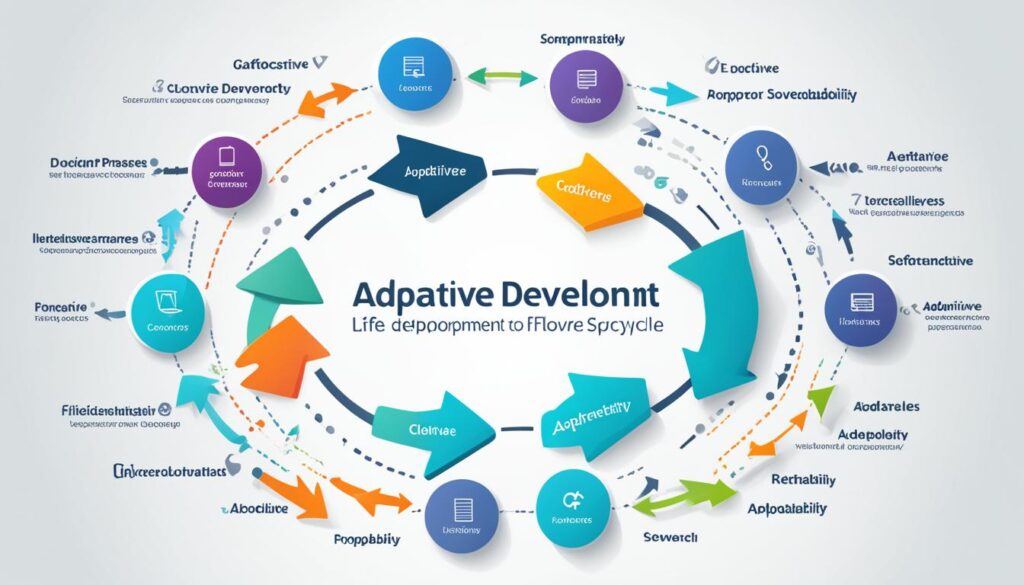Exploring Adaptive Software Development Basics
Wednesday, 6/26/2024, 8 minutes to read

Adaptive Software Development (ASD) has changed the way we make software by putting a big focus on working together and self-organization. This approach was shaped by Jim Highsmith and Sam Bayer, building upon rapid application development (RAD). It works in three parts: Speculation, Collaboration, and Learning. ASD makes teams flexible and quick to adjust, leading to better project outcomes.
The book „Adaptive Software Development,” written by Jim Highsmith in 2000, is highly regarded. It’s been praised for shaking up old development methods and offering practical advice for teams in fast-paced settings. Atlantic Systems Guild and other experts have given it top marks.
John Wolter of Wolter Works, Inc. mentions better project results after using ASD methods. James Bach from Satisfice, Inc., though, says that success lies in understanding the people and working dynamics, not just the steps or paperwork. Online reviews also note how ASD boosts teamwork, creativity, and innovation on big projects.
Key Takeaways
- Adaptive software development loves teamwork and self-organization.
- Created by Jim Highsmith and Sam Bayer as a step past RAD.
- Worked in three steps: Speculation, Collaboration, and Learning.
- Highly praised for breaking traditional software making methods.
- Really improves project results.
What is Adaptive Software Development?
Adaptive Software Development (ASD) is a big change from old ways of making software. It welcomes change and brings people together to work better. This part talks about where ASD started, what it’s based on, and what makes it different from other approaches.
Origins and Evolution
Adaptive Software Development started in the early 90s. John Highsmith and Sam Bayer were key. They built it on Rapid Application Development (RAD) ideas. Highsmith wrote a big book on ASD in 2000. He focused on making software in short, one-month steps. Each step is filled with feedback and new learning. This led to successes like Slack growing fast because it used ASD.
Core Principles
ASD has three main phases: Speculation, Collaboration, and Learning. These help it adapt quickly and make big software systems well. It’s all about being driven by the project’s main goal. It uses features, works in short steps, deals with risks, and can handle changes easily. Highsmith’s idea is that each development phase shapes the next, leading to smart new solutions.
Difference with Other Agile Methodologies
ASD stands out because it loves listening to users and working together over having strict plans. It doesn’t follow the usual waterfall model. Instead, it works in quick, feedback-rich cycles. This is great for projects where things change a lot.
ASD believes in few yet clear rules, which keeps work flowing smoothly. It’s always changing to meet user needs in fast-paced markets.
| Aspect | ASD | Other Agile Methodologies |
|---|---|---|
| Development Approach | Emergent, Iterative | Structured, Iterative |
| Philosophy | User Feedback, Collaboration | Guided Workflow, Predictability |
| Lifecycle | Speculate, Collaborate, Learn | Plan, Execute, Deliver |
| Simplicity vs Complexity | Simplified Rules | Complex Systems |
ASD not only stands out but is great for making software in today’s world.
Phases of Adaptive Software Development
Adaptive Software Development (ASD) has three main phases: speculate, collaborate, learn. Each one focuses on different aspects but all are important for a flexible approach. Let’s look at how these phases come together for successful project management.
Speculation
In the Speculation phase, teams plan and start release cycles based on the project’s needs and risks. They set early goals and strategies to handle changes as the project goes on. This phase gets everything ready, dealing with unknowns and paving the way for what comes next.

Collaboration
Collaboration is key in ASD, supporting teamwork and communication. Team members, stakeholders, and customers work closely. They create a trust-driven space that boosts creativity and problem-solving together. Everybody’s views are heard, leading to strong, flexible project management. This team effort solidifies goals and commitment.
Learning
The Learning phase is all about getting better as a team. It uses feedback sessions, reviews, and evaluations to improve. Activities like technical reviews and post-mortems provide updates for future projects. This phase helps manage risks better and boosts innovative ideas.
Via its three-phase model, ASD turns old project management ways on their head. It keeps the focus on user feedback and keeps the team learning. This strategy makes sure projects meet changing needs and keeps stakeholders happy.
Benefits and Challenges of Adaptive Software Development

Adaptive Software Development (ASD) is great for fast, complex software projects. It handles changes well, staying transparent and including user feedback. ASD uses a lean method to lower risks and find new solutions.
ASD shines with its ongoing software improvements. It delivers in steps and welcomes feedback, letting teams quickly adjust to what customers want. This method really speeds up how teams respond to changes, fitting well in today’s fast-moving markets.
Now, let’s focus on ASD’s main agile development benefits and software development challenges:
| Benefits | Challenges |
|---|---|
|
|
ASD boosts teamwork by combining different know-hows. This mix increases how well the team works together and its learning abilities. But, working with ASD can be tricky. It might lose focus because initial plans are too broad. Also, the need for lots of testing can mean higher costs, a big challenge for ASD projects.
However, ASD’s strengths are hard to ignore. It’s especially good for projects needing lots of changes and user input. By focusing on small steps and always talking to users, teams can deal with unknowns better. This approach leads to better software in the end.
Conclusion
Adaptive Software Development (ASD) started in the early 1990s and changed how we work on complex projects. It focuses on short development cycles, often a week long. This way, teams work closely together, learn as they go, and adjust quickly. These steps, speculate, collaborate, and learn, keep projects flexible for any changes.
One key thing about ASD is its strong connection with users. It’s great at using feedback to move forward and find even better solutions. This approach speeds up creating software that meets people’s needs. By 2026, digital transformation spending may hit $3.4 trillion. This shows how vital methods like ASD are becoming for the future. Even though it may take more time to plan initially and requires a lot of effort, the benefits are worth it. They include better teamwork and reaching project goals faster.
Compared to other methods like Scrum and Feature-Driven Development (FDD), research often finds ASD to be more adaptable. It helps everyone see the same goals clearly and avoid unnecessary work. ASD is great at promoting new ideas within teams, which is crucial in software development. While some might be slow to accept it, ASD’s focus on users and adaptability usually leads to success. It helps create software that truly answers people’s needs.
FAQ
What is Adaptive Software Development?
Adaptive Software Development (ASD) is about people working together and making progress bit by bit. It was invented by Jim Highsmith and Sam Bayer. They took the main ideas of rapid application development (RAD) and added more focus on teamwork.
What are the origins and evolution of Adaptive Software Development?
Jim and Sam started Adaptive Software Development based on RAD’s principles. They wanted to deal with the challenges of software projects that change quickly. This method allows for more flexibility.
What are the core principles of Adaptive Software Development?
The heart of Adaptive Software Development is Speculation, Collaboration, and Learning. It’s all about making plans, working together, and learning from each step to handle changes smoothly.
How does Adaptive Software Development compare with other agile methodologies?
ASD is different from some agile methods like Scrum or Kanban. Instead of strict rules, it focuses on creating simple solutions that adjust to the project’s needs over time. This approach is more flexible.
What happens during the Speculation phase of ASD?
The Speculation phase begins with the first project plans. Teams start to see how they will meet the project’s goals. This phase understands that plans might change as the project goes on.
What is the role of Collaboration in Adaptive Software Development?
Collaboration in ASD creates a friendly, creative work environment. It’s all about working together, trusting each other, and finding new ways to solve problems. This happens all the time as the project moves forward.
How does the Learning phase contribute to ASD?
In the Learning phase, teams work to get better at what they do best. They use things like focus groups and looking back on what they’ve done to learn. This way, they keep improving with each project stage.
What are some benefits of Adaptive Software Development?
ASD is good for making complex software quickly and managing changes well. It’s open and close with users’ ideas, which is a big plus. This approach also helps reduce risks in software projects.
What challenges might teams face with Adaptive Software Development?
Teams in ASD might find it hard if they don’t plan enough at the start. Also, they need a lot of input from users. To handle these hurdles, teams need to be really adaptable and skilled.
How does Adaptive Software Development fit into the broader context of Agile Development Methodology?
ASD is one of the methods under the agile umbrella that focuses on teamwork and making steady progress. It stands out because of its creative yet structured way of adapting to changing project needs.
Other blog posts
Revolutionize your business with cutting-edge technology!
Let’s Bring Your Vision to Life—Contact Us Today!
📝 Get an Estimate